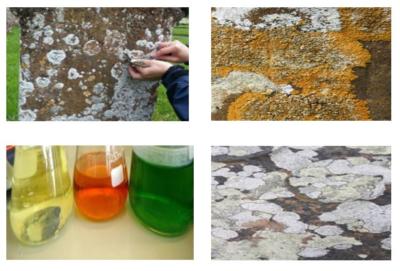The antimicrobial properties of churchyard lichens

The Microbiology Society is undertaking a project entitled A Sustainable Future as part of our 75th Anniversary, which aims to highlight the Sustainable Development Goals (SDGs) to our members and empower them to use their research to evidence and impact the goals. Earlier this year, we put a call out to our members to submit case studies in the following three areas: antimicrobial resistance, soil health and the circular economy.
This case study is written by Dr Judith Taylor, who is a Lecturer at The Open University Graduate School (School of Environment, Earth & Ecosystem Sciences) and a member of the Microbiology Society. It focuses on antimicrobial resistance; a naturally occurring process, whereby micro-organisms (bacteria, viruses, fungi and parasites) can change and adapt over time, either by modifying the target of the antimicrobial, or by developing and exchanging resistance genes.
What are the challenges that this research addresses?
Antimicrobial resistance within populations of microbial pathogens is not new. Salvarsan, produced to treat syphilis in 1909, was described as a “magic bullet”, the world’s first antimicrobial and most prescribed drug. This inevitably led (with hindsight) to the emergence of resistant strains. Suphonamides followed on in the 1930s (Shambaugh, 1966). My mother trained at the Royal Victoria Infirmary in Newcastle at the end of that decade, and it was through her nursing anecdotes that my interest in microbiology arose. M&B 693, a Sulphonamide, was first prescribed in 1938 and was reputed to have saved Winston Churchill’s life from pneumonia during World War II. The range of medicinal chemistries that followed, including Penicillin, transformed medicine and midwifery into the 1940s (Loudon, 2000).
Despite the lesson of resistance to Salvarsan, antimicrobial use has not been controlled and regulated effectively and overuse has made short term economic gains at the cost of long term, medically significant, antimicrobial resistance (Cooper 2000). The rate at which microbes can move around our planet, taking antimicrobial resistance genes with them, has been paralleled and has been evidenced most recently by the COVID-19 pandemic. Resistant bacteria are, like the coronavirus, lethal stowaways on humans in global transit.
What findings and solutions were provided by this research/initiative?
Our research was inspired by the emergence of multi-drug resistant bacteria which have driven the need for novel antibiotics. While surveying gravestones with expert Mark Powell from the British Lichen Society, and Toscane Fourie, from the Institut de Recherche Biomedicales des Armees, Aix-Marseille University, France; our interest grew in the boundaries between different lichen species (Figures 2 and 4). These visually engaging mosaics suggested interactions, which piqued our interest in potential antimicrobial action. Mark’s microscopic examinations of the heavily pigmented zones where competing species abutted, led us to consider if there could be localized chemistry associated with an anti-fungal fight.

(Fig. 1) Sample collection method from gravestones (collecting Diploicia canescens). (Fig. 2) Caloplaca flavescens (Fig. 3) Acetone extracts from three common lichen. (Fig. 4) The mosaic patterning of “competing” lichens including Lecanora sulphurea.
Interest in lichens as folklore remedies diminished with the growing influence of science in medicine and the discovery and commercialization of antibiotics in the early 20th Century. Their most recent significance has been as indicators of air quality (Hawksworth & Rose 1970). But analytical methods have helped identify many new lichen secondary metabolites and tested their medical utility. These chemistries are not essential for the organism to survive, but likely play an ecological role. Most are unique to lichens and only 10% have been found in free-living fungi or in the plant kingdom (Nash, 2008). A variety of their effects have been referenced including antibiotic, antifungal, antiviral, anti-inflammatory, analgesic, antipyretic, anti-proliferative and cytotoxic (Boustie & Grube, 2005). With recent developments, they are now looking like a potential source of antibiotics and anti-cancer drugs (Shrestha & St Clair, 2013).
Antimicrobial susceptibility tests were developed primarily for clinical use to guide in the choice of an appropriate treatment agent. In our study, lichen material was sampled from 10 common species (Figure 1). Extracts (Figure 3) of these samples were tested against six bacteria and two fungi by disc diffusion susceptibility test. Extracts showed differential inhibition against both Gram-positive bacteria and dermatophytic fungi.
How can this research support the transition to a more sustainable future?
In their review Coates et al. (2011) hypothesized that the global antibiotic discovery process was unsustainable, and that universities should rebuild their antibiotic discovery skills. The rate of discovery should emulate that of earlier decades of discovery 1940–62, if only to keep up with emergent bacterial resistance rates.
"Now, here, you see, it takes all the running you can do, to keep in the same place. If you want to get somewhere else, you must run at least twice as fast as that!": The Red Queen character in Lewis Carroll’s “Through the Looking Glass”.
With these words in mind, a great many approaches to discovery need to be explored at once if we are to keep up the rate of discovery.
What is the future for research and innovation in this area?
Exciting approaches utilising Artificial Intelligence (Stokes et al. 2020) have approached discovery through training neural networks with the capability of predicting molecules with antimicrobial activity, by scanning existing chemical libraries for look-a-like antibiotic functionality. Halcin is the first interesting candidate from this process.
Our future lichen studies should identify precisely which active agents we have found in our extracts. Chemical defense strategies adopted by slow-growing lichens against fungal attack may show beneficial medical applications that could be clinically significant against infections in the future. Finally, we need to consider the control of any novel antimicrobials we discover and prevent future misuse and abuse.
References
Shambaugh Jr., G.E. (1966) History of Sulphonamides. Arch Oto laryngol: 83 (1):1-2
Hawksworth D.L & Rose F. (1970). Qualitative Scale for estimating Sulphur Dioxide Air Pollution in England and Wales using Epiphytic Lichens. Nature 227 145-148
Cooper (2000) Australian Infection control vol 5, issue 2 winter
Nash, T. (2008) Lichen Biology. 2 ed. New York: Cambridge University Press.
Boustie, J. & Grube, M.(2005) Lichens-a promising source of bioactive secondary metabolites. Plant Genetic Resources: Characterization and Utilization 3 (2) pp.273-287.
Shrestha, G. & St Clair,L.(2013) Lichens: a promising source of antibiotic and anti cancer drugs. Phytochemistry Reviews, 12 910 229-244
Fourie, T. (2013) Screening antimicrobial activity of ten common English churchyard lichens. Cranfield University MSc Health and the Environment.
Coates, A.R.M., Halls, G., and Hu, Y. (2011). Novel classes of antibiotics or more of the same? B.J.P. 163 184-194
Stokes, J.M, Yang, K., Swanson, K., Jin, W., Cubillos-Ruiz, A., Donghia N.M., MacNair C.R., French S., Carfrae, L.A., Bloom-Ackermann, Z., Tran, V.M., Chiappino-Pepe, A., Badran, A.H., Andrews, I. W., Chory, E.J., Church, G. M., Brown, E.D., Jaakkola, T. S., Collins J.J. (2020). A Deep Learning Approach to antibiotic Discovery. Cell 180 (4): 688-702
About the author

This case study is written by Dr Judith Taylor, who is a Lecturer at The Open University Graduate School (School of Environment, Earth and Ecosystem Sciences) and a member of the Microbiology Society. More information about her work is available here.


